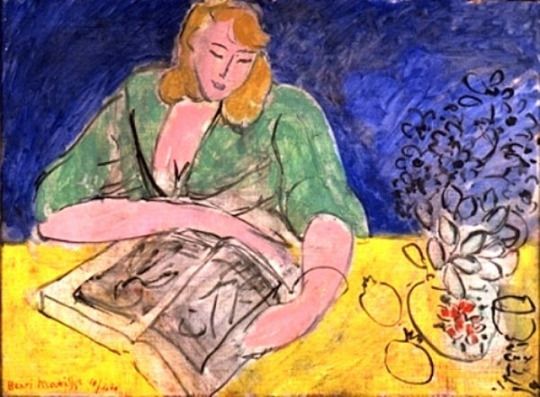Description
In the work "Teacher at the Yellow Table" (1944) by Henri Matisse, the viewer is faced with a prominent example of the artist's mature style, characterized by the simplification of forms and the bold use of color. This painting, with its dimensions of 54x40 cm, is a window into the mind of a genius who, even in the darkest moments of World War II, was able to produce pieces full of vitality and expression.
Observing the composition, we find ourselves in an intimate interior, where a yellow table stands out in the foreground. This central element serves not only as a spatial reference point but also as a vibrant chromatic contrast that stands out in the peaceful environment. The use of bright yellow brings a sense of warmth and energy, infusing life into the scene.
In the representation, we discover the figure of a teacher – her identity remains anonymous – sitting by the table. The woman's posture, leaning forward and seemingly absorbed in her work, suggests an atmosphere of concentration and dedication. Matisse, always master in capturing the human essence, manages to convey the seriousness and devotion to work of this female figure.
The background of the composition is dominated by neutral tones, which effectively contrast with the brightness of the table. Matisse employs a relatively limited palette but does so masterfully, allowing the colors to complement and enhance each other. This chromatic strategy is characteristic of his work in this period and demonstrates his ability to organize pictorial space coherently and harmoniously.
It is important to highlight that, although the painting seems simple at first glance, the handling of space and forms reveals a hidden complexity. The curved lines and soft edges used by Matisse suggest an influence of Fauvism, a movement of which he was one of the main exponents. His unwavering emphasis on the purity of color and his indifference to detailed realism are easily evident in this work.
The presence of the open window in the background adds an additional dimension to the painting. It opens the enclosed interior space to the exterior, suggesting a link between the private and the public, an extension of intimacy to the world. This resource is not unusual in Matisse's repertoire, who often used windows and views to the outside as a means to integrate different dimensions of visual experience.
It is relevant to place "Teacher at the Yellow Table" within the broader context of Matisse's artistic production. paintings from this period, such as "La Blusa Rumana" (1940) or "Interior with Egyptian Curtain" (1948), share the same commitment to chromatic exploration and expressive fullness. In all of them, we observe how Matisse transforms everyday scenes into representations full of meaning and beauty.
Henri Matisse, throughout his prolific career, continued to evolve and refine his style. Late works like these, created when the artist had already reached creative maturity, are testimonies to his inexhaustible energy and his ability to find new ways to see and represent the world. "Teacher at the Yellow Table" encapsulates many of Matisse's visual and conceptual achievements, offering a silent meditation on the importance of education, private space, and the interaction between color and form.

